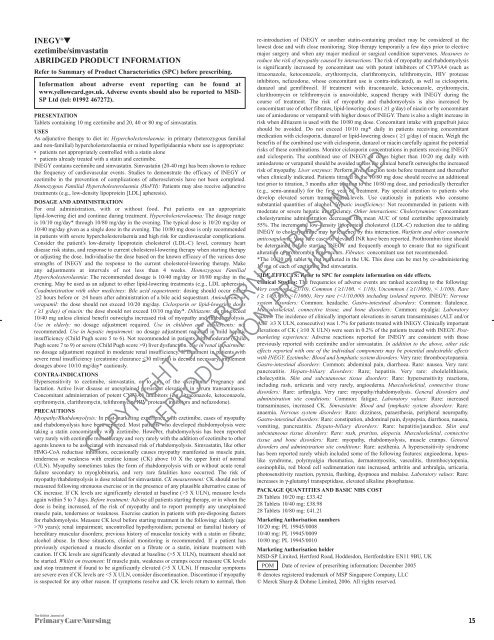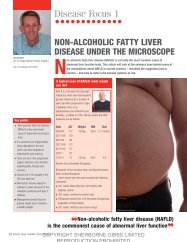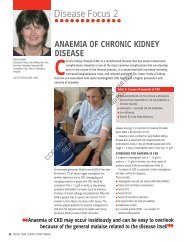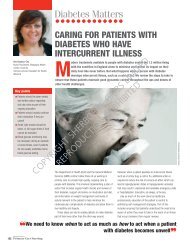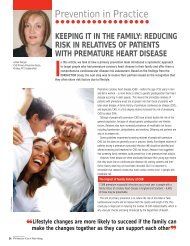EZETROL®▼(ezetimibe)ABRIDGED PRODUCT INFORMATIONRefer to Summary of Product Characteristics (SPC) before PrescribingInformation about adverse event reporting can be found atwww.yellowcard.gov.uk. Adverse events should also be reported to MSD-SPLtd (tel: 01992 467272).PRESENTATION10 mg Tablet containing 10 mg of ezetimibe.USESAs adjunctive therapy to diet in:Primary hyper<strong>cholesterol</strong>aemia: <strong>For</strong> co-administration with an HMG CoA reductase inhibitor(statin) for patients with primary (heterozygous familial and non-familial)hyper<strong>cholesterol</strong>aemia not appropriately controlled with a statin alone. Monotherapy: <strong>For</strong> usein patients with primary (heterozygous familial and non-familial) hyper<strong>cholesterol</strong>aemia inwhom a statin is considered inappropriate or is not tolerated. Homozygous FamilialHyper<strong>cholesterol</strong>aemia (HoFH): <strong>For</strong> co-administration with a statin, for use in patients withHoFH. Patients may also receive adjunctive treatments (e.g. LDL apheresis). Homozygoussitosterolaemia (phytosterolaemia): <strong>For</strong> use in patients with homozygous familialsitosterolaemia.Studies to demonstrate the efficacy of ‘Ezetrol’ in the prevention of complications ofatherosclerosis have not yet been completed.DOSAGE AND ADMINISTRATION<strong>For</strong> oral administrationPut patients on an appropriate lipid <strong>lowering</strong> diet and continue during treatment.Recommended dose is one ‘Ezetrol’ 10 mg tablet daily, administered at any time of the day,with or without food.When added to a statin, either continue with the indicated usual initial dose of that particularstatin or the already established higher statin dose. Consult the statin dosage instructions.Co-administration with bile acid sequestrants: Dosing should occur either 2 hours before or4 hours after administration of a bile acid sequestrant.Use in paediatric patients: Children 9) liver dysfunction.CONTRA-INDICATIONSHypersensitivity to any component. When co-administered with a statin, refer to the statinSPC. ‘Ezetrol’ co-administered with a statin during pregnancy and lactation. ‘Ezetrol’ coadministeredwith a statin in patients with active liver disease or unexplained persistentelevations in serum transaminases.PRECAUTIONSLiver enzymes: When co-administered with a statin, perform liver function tests at initiationof therapy and according to the statin SPC. Skeletal muscle: In post-marketing experiencewith ‘Ezetrol’, myopathy and rhabdomyolysis have been reported. Most patients whodeveloped rhabdomyolysis were taking a statin concomitantly with ‘Ezetrol’. However,rhabdomyolysis has been reported very rarely with ‘Ezetrol’ monotherapy and very rarelywith the addition of ‘Ezetrol’ to other agents known to be associated with increased risk ofrhabdomyolysis. If myopathy is suspected based on muscle symptoms or is confirmed by acreatinine phosphokinase (CPK) level >10 times the ULN, immediately discontinue ‘Ezetrol’,any statin, and any of these other agents. Advise all patients starting therapy with ‘Ezetrol’ ofthe risk of myopathy and to report promptly any unexplained muscle pain, tenderness orweakness. Hepatic insufficiency: Not recommended in patients with moderate or severehepatic insufficiency due to the unknown effects of the increased exposure to ‘Ezetrol’.Fibrates: <strong>The</strong> safety and efficacy of co-administration have not been established. <strong>The</strong>re is apossible risk of cholelithiasis and gall-bladder disease in patients receiving fenofibrate and‘Ezetrol’. If suspected, conduct gall-bladder investigations and discontinue co-administration.Ciclosporin: Exercise caution when initiating ‘Ezetrol’ in patients taking ciclosporin andmonitor ciclosporin concentrations. Warfarin, another coumarin anticoagulant or fluindione:Monitor the International Normalised Ratio (INR) if taken together with ‘Ezetrol’. Excipient:‘Ezetrol’ tablets contain lactose: do not use in patients with rare hereditary problems ofgalactose intolerance, Lapp lactase deficiency or glucose-galactose malabsorption.Interactions (studies have only been performed in adults): Colestyramine: Concomitantcolestyramine administration decreased the mean AUC of total ‘Ezetrol’ approximately 55%.<strong>The</strong> incremental low density lipoprotein <strong>cholesterol</strong> (LDL C) reduction due to adding‘Ezetrol’ to colestyramine may be lessened by this interaction. Statins: No clinicallysignificant pharmacokinetic interactions were seen upon co-administration with atorvastatin,simvastatin, pravastatin, lovastatin, fluvastatin, or rosuvastatin.Pregnancy and lactation: ‘Ezetrol’ co-administered with a statin is contra-indicated duringpregnancy and lactation, refer to the SPC for that particular statin.Pregnancy: ‘Ezetrol’ should be given to pregnant women only if clearly necessary. No clinicaldata are available on the use of ‘Ezetrol’ during pregnancy.Lactation: ‘Ezetrol’ is contra-indicated.SIDE EFFECTSRefer to SPC for complete information on side effectsClinical studiesIn clinical studies where ‘Ezetrol’ was administered alone or with a statin, adverse reactionswere usually mild and transient. <strong>The</strong> overall incidence of side effects reported with ‘Ezetrol’was similar between ‘Ezetrol’ and placebo. Similarly, the discontinuation rate due to adverseexperiences was comparable between ‘Ezetrol’ and placebo.<strong>The</strong> following common (1/100, 10 X ULN was reported for 4 of 1,674 (0.2%) patients administered‘Ezetrol’ alone vs 1 of 786 (0.1%) patients administered placebo, and for 1 of 917 (0.1%)patients co-administered ‘Ezetrol’ and a statin vs 4 of 929 (0.4%) patients administered astatin alone. <strong>The</strong>re was no excess of myopathy or rhabdomyolysis associated with ‘Ezetrol’compared with the relevant control arm (placebo or statin alone).Post-marketing experience<strong>The</strong> following additional adverse reactions have been reported in post-marketing experience:[Rare (1/10,000,
INEGY ® ▼ezetimibe/simvastatinABRIDGED PRODUCT INFORMATIONRefer to Summary of Product Characteristics (SPC) before prescribing.Information about adverse event reporting can be found atwww.yellowcard.gov.uk. Adverse events should also be reported to MSD-SP Ltd (tel: 01992 467272).PRESENTATIONTablets containing 10 mg ezetimibe and 20, 40 or 80 mg of simvastatin.USESAs adjunctive therapy to diet in: Hyper<strong>cholesterol</strong>aemia: in primary (heterozygous familialand non-familial) hyper<strong>cholesterol</strong>aemia or mixed hyperlipidaemia where use is appropriate:• patients not appropriately controlled with a statin alone• patients already treated with a statin and ezetimibe.INEGY contains ezetimibe and simvastatin. Simvastatin (20-40 mg) has been shown to reducethe frequency of cardiovascular events. Studies to demonstrate the efficacy of INEGY orezetimibe in the prevention of complications of atherosclerosis have not been completed.Homozygous Familial Hyper<strong>cholesterol</strong>aemia (HoFH): Patients may also receive adjunctivetreatments (e.g., low-density lipoprotein [LDL] apheresis).DOSAGE AND ADMINISTRATION<strong>For</strong> oral administration, with or without food. Put patients on an appropriatelipid-<strong>lowering</strong> diet and continue during treatment. Hyper<strong>cholesterol</strong>aemia: <strong>The</strong> dosage rangeis 10/10 mg/day* through 10/80 mg/day in the evening. <strong>The</strong> typical dose is 10/20 mg/day or10/40 mg/day given as a single dose in the evening. <strong>The</strong> 10/80 mg dose is only recommendedin patients with severe hyper<strong>cholesterol</strong>aemia and high risk for cardiovascular complications.Consider the patient’s low-density lipoprotein <strong>cholesterol</strong> (LDL-C) level, coronary heartdisease risk status, and response to current <strong>cholesterol</strong>-<strong>lowering</strong> therapy when starting therapyor adjusting the dose. Individualise the dose based on the known efficacy of the various dosestrengths of INEGY and the response to the current <strong>cholesterol</strong>-<strong>lowering</strong> therapy. Makeany adjustments at intervals of not less than 4 weeks. Homozygous FamilialHyper<strong>cholesterol</strong>aemia: <strong>The</strong> recommended dosage is 10/40 mg/day or 10/80 mg/day in theevening. May be used as an adjunct to other lipid-<strong>lowering</strong> treatments (e.g., LDL apheresis).Coadministration with other medicines: Bile acid sequestrants: dosing should occur either≥2 hours before or ≥4 hours after administration of a bile acid sequestrant. Amiodarone orverapamil: the dose should not exceed 10/20 mg/day. Ciclosporin or lipid-<strong>lowering</strong> doses( ≥1 g/day) of niacin: the dose should not exceed 10/10 mg/day*. Diltiazem: do not exceed10/40 mg unless clinical benefit outweighs increased risk of myopathy and rhabdomyolysis.Use in elderly: no dosage adjustment required. Use in children and adolescents: notrecommended. Use in hepatic impairment: no dosage adjustment required in mild hepaticinsufficiency (Child Pugh score 5 to 6). Not recommended in patients with moderate (ChildPugh score 7 to 9) or severe (Child Pugh score >9) liver dysfunction. Use in renal impairment:no dosage adjustment required in moderate renal insufficiency. If treatment in patients withsevere renal insufficiency (creatinine clearance 5 X ULN), measure levelsagain within 5 to 7 days. Before treatment: Advise all patients starting therapy, or in whom thedose is being increased, of the risk of myopathy and to report promptly any unexplainedmuscle pain, tenderness or weakness. Exercise caution in patients with pre-disposing factorsfor rhabdomyolysis. Measure CK level before starting treatment in the following: elderly (age>70 years); renal impairment; uncontrolled hypothyroidism; personal or familial history ofhereditary muscular disorders; previous history of muscular toxicity with a statin or fibrate;alcohol abuse. In these situations, clinical monitoring is recommended. If a patient haspreviously experienced a muscle disorder on a fibrate or a statin, initiate treatment withcaution. If CK levels are significantly elevated at baseline (>5 X ULN), treatment should notbe started. Whilst on treatment: If muscle pain, weakness or cramps occur measure CK levelsand stop treatment if found to be significantly elevated (>5 X ULN). If muscular symptomsare severe even if CK levels are


